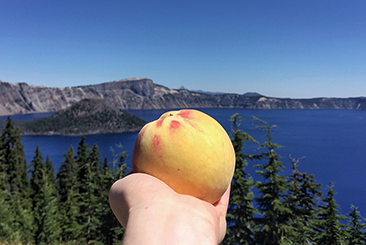Squash Blossom, Cherry Tomato, Zucchini, Caciocavallo, and Fried Egg Pizza

Earlier this week, Rob and I stopped by Gjelina Take Away and had the breakfast pizza you see above. It was so well balanced. The cherry tomatoes, squash blossoms, and zucchini were bright and fresh while the crust was airy and perfectly charred. The kicker though was the caciocavallo cheese. It had a mild flavor that brought everything together without dominating - a diplomat in the ingredient world. Put an egg on it and you have a summer breakfast pizza that I'd like another slice of.
Since caciocavallo is new to me, I did some Googling and have included what I learned below along with the "Ingredient Inspiration" rundown. The more I read, the more interesting the dairy knowledge got.

One of the challenges I've had with homemade pizza is balancing the quantity and flavor of the the toppings. Sometimes it's too much cheese, sometimes I can't taste the cheese at all. When eating out, I'm always in awe when every ingredient in a dish perfectly compliments the other. You can't quite put your finger on the flavor you're detecting but it just works. It's damn hard to develop and execute food like that.
In terms of the breakfast pizza at GTA, both Rob and I commented on how mellow the caciocavallo was and yet how well it played with the other ingredients. Subtle pairings are especially difficult so I made a note of the cheese and did a little research.
Caciocavello Cheese
What is caciocavallo cheese?
Caciocavallo (meaning cheese on horseback or horse cheese) originates in the southern regions of Italy. Apparently the name is linked to how the cheese is tied in pairs and draped over a pole to age, similar to how you would drape saddlebags over a horse. Several sites also suggested that, back around 500 B.C., Hippocrates mentioned caciocavallo when discussing the Greek culinary arts. I can't find any additional information on that bit of trivia, but since the Interwebs never (ever) makes things up I'll repeat the potentially mythical fact here.
Caciocavello is part of the "pasta filata" family that includes mozzarella and provolone. In short, pasta filata styles of cheese are made from drawn or stretched curd. This article has some more information on the history and process as well as a recipe if you're feeling ambitious.
What is the flavor of caciocavallo?
One site described caciocavallo as mozzarella on steroids or provolone with manners. I do like a polite cheese. The general aging process and flavor can be broken down as follows:
- Semi-Stagionato is aged for sixty days and has a slightly sweet flavor and creamy texture. This is the most popular and least expensive type.
- Stagionato is aged for 4-6 months and has a drier texture. The flavor is saltier, sharper, and has additional spicy notes.
- Stagionato “extra" is aged in a cave for up to two years and is the most rare and expensive version of the cheese. The texture is dry and crumbly with an intense flavor. One site recommends eating this cheese after dinner with a sweet dessert wine.
- Affumicato is the smoked variety.
Artisans and The Presidia Project
Caciocavallo Silano is the PDO (or DOP) variety of the cheese. What does this mean? According to Wikipedia, "...to receive the PDO status, the entire product must be traditionally and entirely manufactured (prepared, processed, and produced) within the specific region and thus acquire unique properties." The Italian government has designated Basilicata, Calabria, Molise and Puglia as the regions where caciocavallo silano can be made (see map below). The overall goal is to protect the integrity of this regional food. So, if your caciocavallo doesn't have DOP on the label then it doesn't fall within the Italian guidelines for the product. This doesn't mean you should throw the cheese down on the floor in disgust, but it's good to be an informed consumer.
Caciocavallo podolico (PDO/DOP) is considered by many to be one of the best examples of the cheese. The milk comes from a special breed of cow called the "podolica" that used to roam all over Italy but is now only in the southern regions where the terrain is rugged and somewhat harsh. Each spring and summer, the herds are moved to higher elevations where they feed on wild shrubs, berries, and aromatic plants. Though the cows have a relatively low milk output (they're only milked once a day during the warmer months), what they produce is high in fat and especially aromatic. I looked for the cheese online and found the price to be about $50/pound. That's one fancy-pants cheese plate.

Caciocavallo podolica is also part of the The Presidia Project which identifies artisanal foods, techniques, or rural ecosystems that are at risk of extinction. As a result of its low milk output, the podolico cows have gradually been replaced with more productive breeds. If the podolica vanish from southern Italy, so goes caciocavallo podolica. There's also the fact that transhumance is a dying practice which is directly impacting the podolico cow and its milk production. An article the subject can be found here.The Slow Food Foundation is working to help the local artisans and help create a better commercial climate for the cheese.
In the United States, the Sebastopol Gravenstein apple is part of The Presidia Project along with American raw milk cheeses. One of my favorite farmers, Windrose, grows Gravenstein and sells them at the Santa Monica Farmers Market. There's also a 2013 article about the tenuous future of the apple here.
How to cook with caciocavallo cheese.
The younger varieties are great for eggs, pizza, and general melting purposes. The aged caciocavallo, especially such special styles as caciocavallo podolico, are best enjoyed simply sliced or on a cheese plate.
And if you just can't get enough...
Here's a short shaping video.
Ingredient Inspiration
- Pizza Dough
- Caciocavallo Cheese Note: The younger caciocavallo is going to be the best choice since it has a mild flavor.
- Olive Oil
- Cherry Tomatoes
- Squash Blossoms
- Baby Zucchini
- Fried Egg
- Thyme
- Flake-style Salt and Freshly Ground Pepper






